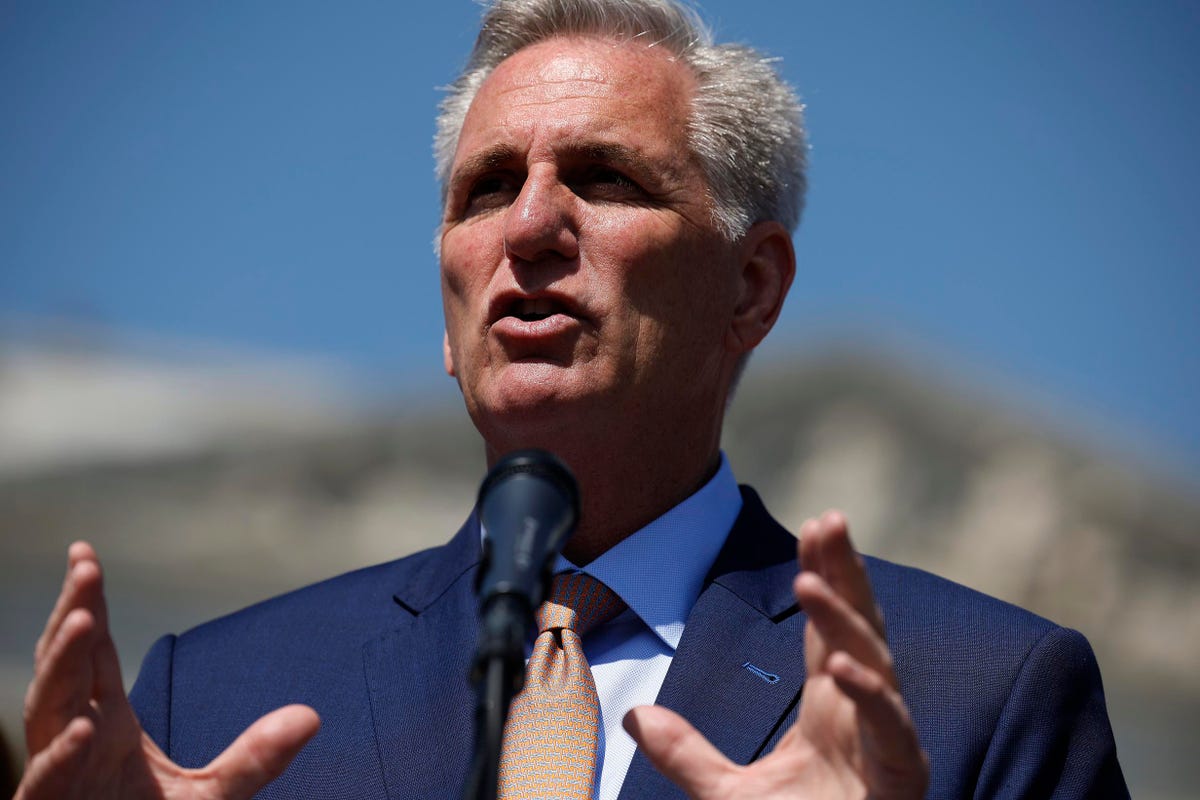You can see where this is going. As the US gets ever closer to hitting its borrowing limit sometime this summer, Congress is stumbling towards its usual off-ramp: Finding a way to continue borrowing while avoiding the hard choices needed to reduce deficits and slow the growth of the ever-increasing debt.
At the moment, at least four ideas are on offer, all aimed at addressing the messy mix of long-term federal budgeting and short-term borrowing needs. One is a serious, if modest, effort to reduce spending and raise taxes.
The others are…not. Instead, they are face-saving efforts to paper over the debt limit problem by pretending to confront deficits, without really doing so.
The House GOP Plan
Let’s start with the House Republican majority, which passed a broad budget framework yesterday with one vote to spare. It began the year threatening to block any increase in the debt limit unless Democrats agreed to cut spending enough to balance the federal budget within a decade.
Then reality, and math, intervened. Under political pressure, Republicans first jettisoned plans to scale back spending for Social Security, Medicare, the military, and veterans. Since tax increases never were on the table, they came to realize that the only way they could approach balance was to eliminate the entire rest of government, including such GOP faves as border security and farm subsidies.
That left House Speaker Kevin McCarthy (R-CA) trying to thread the needle between a hard-core anti-government faction and more moderate Republicans who seem increasingly nervous about deep domestic spending cuts.
To do it, he drafted a 320-page spending-cut plan that somehow never quite describes just what he’d cut. The Committee for a Responsible Federal Budget has the details here.
Three-quarters of McCarthy’s deficit reduction would come from bringing total discretionary spending down to fiscal year 2022 levels, then increasing that spending by no more than 1% annually. But does McCarthy mean all such spending or just some? He doesn’t say. Would he exempt the military and veterans from these cuts? Probably. But the bill doesn’t say. And since his plan is unlikely to ever get turned into an actual budget, we’ll never know.
The Congressional Budget Office estimated the House GOP plan would reduce projected deficits by about $4.8 trillion over 10 years while kicking the debt limit can down the road for about a year, when we’d do it all again in the midst of campaign season.
$4.8 trillion is a lot of money but only about one-quarter of the way to a balanced budget. If the GOP could agree on this level of real cuts. Which it almost certainly can’t.
Biden’s Plan
President Biden’s budget is a mirror imagine of McCarthy’s. Instead of cutting federal programs, Biden would boost spending by almost $3 trillion. But he’d pay for it all and reduce the debt by about $3 trillion almost entirely by raising taxes on high income households and corporations.
But just as the House GOP plan never will even get a vote in the Democratic-controlled Senate, Biden’s budget is doomed in the Republican-controlled House. Besides, the president says he won’t even talk about the debt limit in the context of a budget.
Solving One Problem
In the sort-of middle is a bipartisan group of about 60 House members who call themselves the Problem Solvers Caucus. Their plan would extend the debt limit to 2025 in exchange for some budget process reforms and, heaven help us, a new commission tasked with recommending some combination of spending cuts and tax increases.
This may temporarily solve the debt limit problem. But a fistful of new budget rules and another fiscal study will solve no other problems.
Fiscal commissions are a tried-and-true way for Congress to do nothing. Most come up with perfectly good ideas that Congress ignores. There is no secret to reducing the deficit. Lawmakers already know how. They just don’t want to.
It is the same with budget process reforms. Unless Congress really wants to cut spending and raise taxes, it will find ever-more clever ways to ignore its own fiscal rules.
Then there is a plan from Rep. Jared Golden (D-ME), which got a Beltway boost from a column in The Washington Post. Golden, a member of the Problem Solvers group, aims to reduce annual borrowing by $250 billion for two years. He’d get there by adopting a 50/50 mix of GOP caps on domestic spending (except for Medicare and Social Security) and Democratic tax increases on high-income households and corporations.
The Coming Fiscal Cliff
If Congress ever decides to tackle deficit reduction, it will agree to something along Golden’s lines. But at the moment he has zero co-sponsors for his plan, an indication of the enthusiasm today’s Congress has for real spending cuts and tax increases.
There will be much drama over the next few months. We’ll likely watch another of Congress’s self-made last-minute crises where the US reaches the precipice of the debt limit cliff. It may even stumble briefly over the edge. Or, under pressure from businesses and the financial markets, Congress may stop just short of disaster. But what it won’t do is enact meaningful deficit reduction.
Read the full article here









